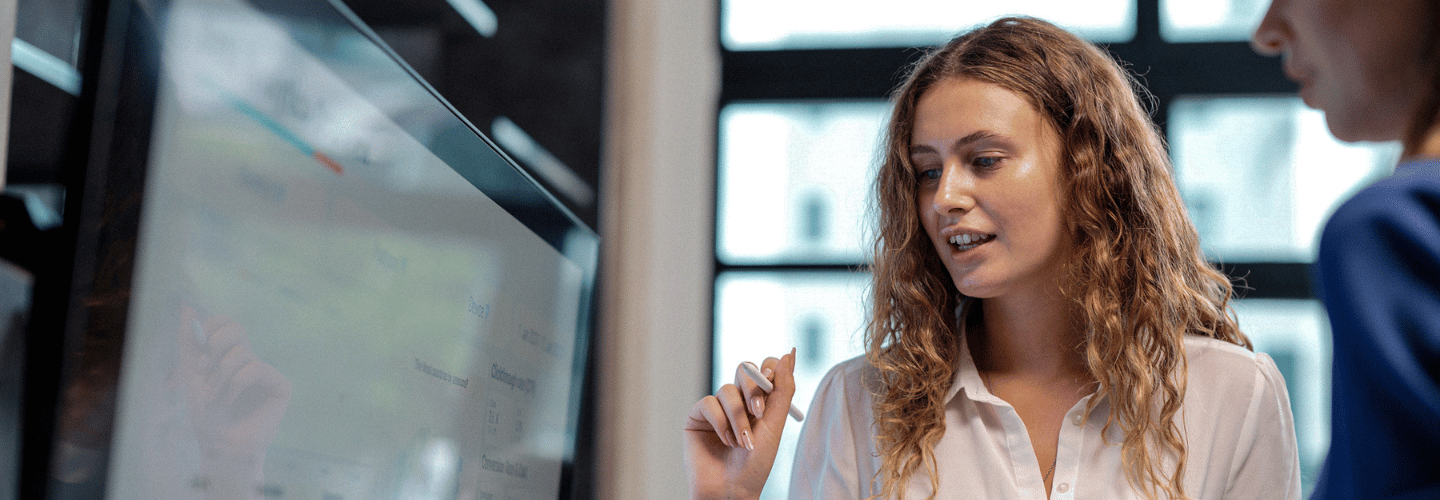
Following the outbreak of COVID-19, working professionals fled office buildings and retreated to kitchen tables, living rooms, and home studies around the world. Business leaders—most navigating the remote workplace for the first time—reacted quickly and decisively. After all, business continuity depended on it.
As some employees continue to work from home and others venture back into the office, a transformative work paradigm emerges: the HybridHQ, more commonly known as the hybrid workplace. While the immediate threat of the virus forced businesses into a reactive stance, hybrid work warrants a proactive, intentional transformation strategy. Like any transformation, approaching the hybrid workplace requires clarity around purpose and priorities—paired with the corresponding activities needed to realize anticipated value.
In the first blog of this five-part series, we explored the importance of defining and aligning on your hybrid workplace transformation strategy. Then we unpacked some essential design considerations, particularly related to employee experience. Here, we’re keeping with the people-centric theme as we explore organizational culture in the hybrid workplace.
Microsoft’s 2021 Work Trends Index Report revealed that 73 percent of employees surveyed want flexible remote work options to continue, while 67 percent would like more in-person time with their teams. What these numbers tell us is that we are racing toward a future state of work faster than previously imaginable. And as the workplace quickly transitions into a hybrid environment, your organization’s culture must evolve with it.
Even for those that believe they’ve reached the pinnacle of setting and managing their cultural experience, the adaptability of that culture in this new paradigm remains to be seen – and it will likely need to evolve. Take Microsoft, for example. The organization’s strong growth mindset culture – one that empowers employees to test, learn, and iterate – was tested during the pandemic. The company’s culture had pockets that leveraged in-person collaboration between coworkers and groups. In March 2020, when in-person interactions were no longer viable due to the pandemic, Microsoft needed to quickly adapt and evolve that core element of its culture in order to continue the growth, collaboration, and innovation mindset that had driven its very employer brand. To keep the culture alive, leaders mandated a work-from-home order that leveled the playing field and encouraged employees to innovate the tools they needed to collaborate more effectively. Using the growth mindset culture, anchored in research, test, and learn, Microsoft not only found virtual ways to make its culture come alive but created tools like a watercooler bot in Teams that allowed for more ad hoc collaboration. Other collaboration techniques and innovations, from Whiteboard Teams and Together mode, are embodiments of how Microsoft’s commitment to innovations and a growth mindset have benefitted us all.
As evidenced by Microsoft, culture – which includes the attitudes, values, and beliefs reflected in ways of behaving and working – is a dynamic process, not an inert force. And it can and should be adapted over time to keep your organization resilient in the face of change.
Evolving your culture doesn’t just happen. You need to get intentional and strategic. When evolving your culture for the hybrid environment, take the time to think through what the future of work could look like for every group of employees in your organization. Importantly, during this transition, leaders and employees need to get comfortable being uncomfortable. Much like a college freshman leaving the comforts of home for the first time, the leaders and employees within your organization will need to move through a period of change that will not be without its growing pains. A great leader knows this and will offer grace and time to let employees adapt. Everyone should be willing and tolerant of stepping back and embracing the process – the forming, storming, norming – that needs to happen so that your evolved culture is built to last and support your organization through future change.
To intentionally evolve your culture for the hybrid model:
There’s no going back, only forward
Organizations that wish to create the conditions for an effective hybrid workplace culture must move beyond doing what they’ve always done. Hybrid environments require an approach to culture that differs from more traditional scenarios.
It’s also not enough to simply transplant your existing culture into a hybrid environment. It’s like trying to transplant a meadow somewhere in Arizona; it will die. In attempting to just extend your culture, you’ll run the risk of creating inequities in your organization –setting up “have” and “have nots.” For example, even in an organization that boasts a flexible, hybrid model, there could be some employee groups that do not have the luxury of choosing their work arrangement. These are employees that have to be present (and likely were on-site during the pandemic) because of the nature of their role or the industry in which they operate – think factory, distribution center, and retail store workers, to name a few. What does the future state of work look like for these teams? There will be unique considerations, such as organizational mobility challenges, that leaders need to address to avoid inequities and division.
In our current environment – where there is high attrition and high mobility in jobs – it’s fully possible to transform and adapt the elements of your culture that were not serving your organization in the past. It’s possible to set a new path forward and correct the rights and wrongs of the past. It’s possible to dismantle old norms and create new ones that are considerate and supportive of all the various types of employees that make up your hybrid workforce. That’s in part because there are new players bringing fresh ideas to the table. They don’t carry the historical bias and can serve as an example and motivator for the established cultures that might struggle to leave behind old ways of operating.
To evolve your culture, tackle the things you can change (the “nice to haves”), in addition to the things you must change to thrive in a hybrid world. To do this and position your organization to steer toward new opportunities, revisit the eight culture drivers: vision & values, capabilities, leadership, teamwork, communication, environment, measurement, and recognition.
Bridge the gaps with a strong conductor
As you are evolving your culture for this new model, you’ll need a strong leader (or group of leaders) at the helm – someone who sits at the center of the web of employees that make up your hybrid workforce. A great conductor, if you will.
A conductor’s most important job is keeping the orchestra on time and together. By deeply understanding the music, they are able to unify performers and shape the sound of the ensemble. They control the tempo by communicating at key points in time and listen deeply to ensure the melody is clear and solid, and that all parts work together in harmony. Every beat, every movement is done with style and energy to drive the orchestra forward or to reign in a section whenever it seems they want to do their own thing.
Just like a maestro of musicians, you’ll need a leader dedicated to keeping your hybrid workforce in sync, performing at their highest potential, and driving toward the same goal. This person must understand the various groups of employees and types of work in the hybrid model. They must know the ins and outs of the organization's identity and culture – where it's been, where it is today, and where it's going – to set the components of culture that are foundational truths. These truths, or non-negotiables, are what keep culture strong and resilient in the face of change. Importantly, this leader must have the vision to pull all of the components of the hybrid workforce together to attain success.
But a conductor cannot perform alone. And neither can your leader. You must bring people along the hybrid transformation journey, keeping employees at every level and in every role apprised of changes that may impact them. Your leader should communicate transparently throughout the decision-making process: as they identify what decisions need to be made, as they map out the steps needed to move the organization successfully into the hybrid model, and as decisions need to evolve. Your workforce must know what direction your firm is going in order to have a true impact and help bring the hybrid transformation to life.
Establish purpose and belonging by segmenting without shame
In the same way your workforce needs to have direction to meaningfully support change, they also need a purpose and the resources to contribute. Even if your employees are physically separated, they should feel like they are in the same boat, rowing in the same direction, towards the same goal. As you embark on the shift to hybrid, it’s a great opportunity to revisit your organization’s purpose and remind your workforce of this guiding principle.
Importantly, leaders must ensure that all employees – no matter their level and no matter their location – have the resources to equally contribute. You can’t have some employees with old, wooden paddles and others with best-in-class rowing equipment if you hope to reach your destination quickly and efficiently. Without the tools to succeed, employees will not only be at a disadvantage to other peers; they’ll lose their sense of purpose and belonging – potentially dragging the organization down with them.
To ensure you are providing all of your people with the necessary support to succeed in the hybrid model, you’ll need to segment without shame. This is acknowledging that there are different roles, responsibilities, and ways people show up in the hybrid model, and accepting that one is not better or more celebrated than another. To put this into practice, it is important to survey a representative sampling of employees to better understand their unique situations, preferences, and needs. This will help you define the various segments that make up your hybrid workforce, understand different perspectives and behaviors, and remove any biases so that you can support and recognize everyone in your organization equally. You may find that a group of employees who routinely show up to the office, but have a long commute to get there, require more flexibility in working hours than those who are remote. Over time, this will be embraced and become the norm. Segmenting without shame will help intentionally create a culture where there are no advantages or disadvantages for any one group.
Measure what matters
As your workforce transforms and your culture evolves for the hybrid setting, leaders should measure success in new ways, focusing on what matters, not what’s most obvious. This may mean using more subtle approaches to gather insights, leveraging both pull and push data.
Organizations can pull data – measuring everything from productivity to attrition and more – to understand key areas for improvement. This could take the form of daily pulse surveys of a handful of randomized employees, measuring engagement, satisfaction, quality of relationship with coach/manager, wellness, and work-life balance.
Leaders can also tap into more non-traditional measures, often found in unexpected places, to better understand employee sentiment and make informed decisions in support of culture. This could mean measuring elements such as meeting attendance, engagement with content, or analyzing questions frequently asked by employees. It might be asking new questions to gauge curiosity and creativity (ex. What surprised you this quarter? What did you learn from that?). Culture can and should be actively monitored and managed by leadership to assess engagement, ensure alignment, drive performance levels, and promote resiliency as you make the hybrid workforce transformation.
As you transform your organization for the future of work, be sure your culture doesn’t get left in the past. Culture isn’t static – it is always moving and changing, and during this pivotal chapter, it should evolve just like the rest of your organization. As Microsoft asserts, "The opportunity now is to build on what we've learned over the past 12 months to create a workplace where everyone can thrive." It’s your culture that will keep your hybrid workforce aligned and rallied around a larger cause, even when it’s a blend of in-office employees and remote workers. It’s your culture that will determine whether your organization seizes new opportunities or founders in the face of change – in the face of a new working model. And, it’s culture that will make the hybrid systems and structures that you establish work together so that your organization can continue to adapt in an era where there is just one constant: change.










